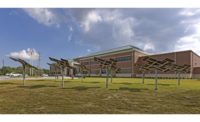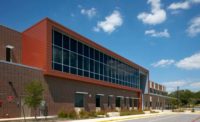Driven by rising energy costs, government mandates, long-term cost savings, and simply doing the right thing for future generations, schools are increasingly turning to engineers and architects to move towards net zero energy consumption. Net zero is defined as carbon neutrality, meaning the amount of greenhouse gases (CO2 being most impactful) produced by a facility is brought to zero by reducing emissions or methods to absorb greenhouse gases. Greenhouse gases are the leading cause of our planet's global warming. Reducing, eliminating, and absorbing greenhouse gases will slow or potentially reverse global warming.
However, achieving net zero is not an easy feat. A better term for the current state of educational institutions is approaching net zero. States like Washington, Oregon, and California are much closer to net zero due to statewide incentives and mandates coupled with the increased rates of utilities in these states. Florida and other states are still far behind Washington, Oregon, and California. Florida, for instance, has much lower energy costs and has moved more slowly towards net zero because the economics are not in place to encourage more investment to improve power use and thus reduce CO2 emissions. When facilities look at the costs of improved building envelopes, wind and solar energy, and new technologies around mechanical and lighting systems, the return on investment is often decades away and simply not economical.
For schools, the largest facility cost is HVAC systems. Heating and cooling costs are reported to consume 42-47% of operational budgets. These costs will only increase as utility companies raise rates. One of the first steps in approaching a net zero goal is designing a structure to minimize loss of energy through building envelopes. Outside air flowing into a building (infiltration) or inside air leaving the building (exfiltration) is detrimental to HVAC efficiency, and a leaky structure will draw substantial power to account for a poor building envelope. Engineers must think creatively about ways to solve this problem because rebuilding or remodeling a facility's envelope is often not in the owner's capital budget.
Thanks to new motor technologies (ECM motors) and thermal energy storage (TES) technologies, engineers are finding ways to utilize incentives to address HVAC costs with a much more rapid return on investment (ROI). One example in Alachua County, Florida, is the new Justice Center Complex which will have a new 800-ton, 32 Calmac ice storage tank central energy plant added to provide chilled water to a six-building complex totaling 270,000 SF. The solution will provide a 3.9-year ROI, 32,256 metric tons per year of CO2e reduction, and an Inflation Reduction Act (IRA) 48 Investment Tax Credit between $500,000 -$1,000,000. Lighting technologies are helping reduce energy usage for schools as well. LED lighting systems that are controlled and provide automated on/off mechanisms reduce electrical use while also cutting down on heat production, which was a byproduct of traditional incandescent bulbs.
Increasingly, government mandates are driving more demand for a move toward net zero. However, it's a mix of mandates and incentives that provide schools with dollar-driven initiatives to improve their use of power and reduce greenhouse gases. Higher education institutions are often in the business of making money, and profits will guide their choices to invest in building technologies that reduce or offset CO2 emissions. It is truly a business decision for many of these institutions, and if the numbers are not in their favor, they will often forego the investment.
While many in the education sector talk about net zero, it is far off for most. Some states provide incentives to drive investment, and those lead the way for others. Ultimately, while it is the right thing to do for the future of our schools, our children, and their children, the investment must make sound economic sense for schools to be willing to rebuild or retrofit facilities. Building technologies have advanced, and they will continue to do so. Creative solutions can help speed the path to net zero, and forward-thinking engineers and architects are leading the charge to offer solutions that make economic sense now, with sound returns in the future.




